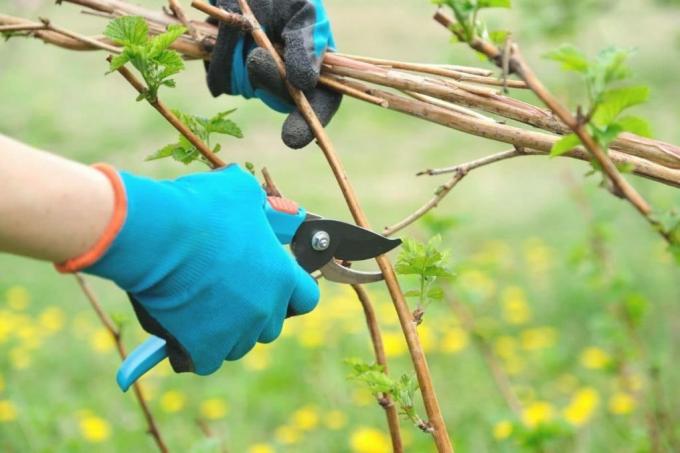
table of contents
- Difference between summer and autumn raspberries
- Cutting summer varieties
- Cut autumn varieties
- Cut back after the next harvest
- frequently asked Questions
Oh no! Autumn is already here and it was forgotten that Raspberries to cut. Now the question arises as to how to proceed. Let the hedge rest or do you want to cut it back quickly before winter?
In a nutshell
- In the case of summer varieties, the removed rods are usually cut back after the harvest
- Note differences between varieties
- Raspberries can survive for a year or more without pruning
- but more dense branching makes harvesting in the following year more difficult
- lower crop yield without pruning, as the plant invests a lot of energy in old canes
Difference between summer and autumn raspberries
Raspberries not all raspberries are created equal. So there are the summer varieties that, as the name suggests, bear their fruit in summer. There are also plants that don't ripen their tasty fruits until autumn. There are other important differences here, which are also not insignificant for the time of cutting:
- Summer raspberries bear fruit on biennial branches
- the annual rods are left here
- only the two year old worn away
- Autumn raspberries show up on annual shoots
- thus all shoots are removed in the year
- all shoots are cut

Note: With the two raspberry varieties, you can assume that the summer raspberries will also after one The cut remains as a hedge, but the autumn varieties are cut back to the base as a whole will.
Cutting summer varieties
Actually, early autumn is the right time to cut for summer varieties. If it is cut later, frost can quickly fall at the interfaces and the bushes could be damaged. If you forget to cut the raspberry bushes after the harvest, you can still do this in spring:
- before the new shoot
- in early spring
- remove the dry wood
- leave everything that is in the juice
Note: If you forget to cut your raspberries after the harvest, this will unfortunately always be at the expense of the next harvest.
Cut autumn varieties
The ideal time for cutting is different for the autumn varieties of raspberries than for the summer varieties. Even if many hobby gardeners also cut these bushes in autumn after the harvest, the right time is different here:
- Cut back only after winter
- Late winter or early spring
- before the next budding

Note: So you haven't forgotten to prune back on your autumn varieties if you haven't cut the shrubs in the autumn after harvest. This is completely normal and is even recommended by gardening experts.
Cut back after the next harvest
If the raspberries were not cut back after the harvest in the previous year, this will not harm the plants. So the old rods can simply remain on the bush:
- next summer after the harvest
- with raspberries from autumn after winter
- then cut everything that no longer supports
- from the previous year and from the current year
Tip: If you skip the cut one year, cut the next year as normal, as it should be. In this way, the raspberry bushes can regenerate and grow normally again in the following year.
frequently asked Questions
Since there can already be significant night frosts in November, pruning the summer varieties is no longer recommended at this time. In such a case, the raspberries survive the winter better without being cut. Because the frost can penetrate through the interfaces and in the worst case damage the plants. However, an uncut raspberry bush can handle frost and snow well.
If you forgot to prune by spring, the new shoots will show up. In the case of summer raspberries, you can remove the old, worn rods, because they are already dry and no longer useful. In the case of autumn raspberries, the fruits show up on annual shoots. Here, too, it is possible to remove the old rods as far as they have dried out.
That is normal. If the bushes have not been cut for a year, the new rods will grow over the old ones and everything looks as if it has grown into one another and is confused. Of course, the pruning after the next harvest is a lot more laborious for you, as you have to separate the old and new rods of the summer raspberries. It is easier with the autumn varieties, where all the rods are cut to the base.



